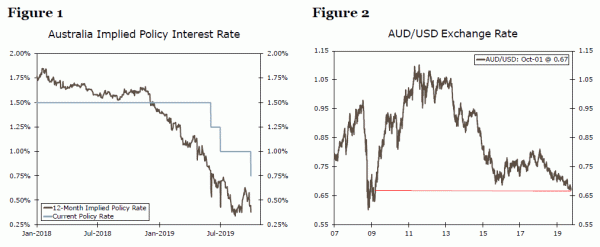Executive Summary
As expected, the Reserve Bank of Australia (RBA) opted to reduce its Cash Rate another 25 bps to 0.75%, marking the third interest rate cut from the Australian central bank this year. In the accompanying statement, the RBA again cited risks to the global economy and monetary easing from major central banks as rationale for the rate cut; however, it also noted that the domestic economy may be starting to improve. While the RBA may be turning more hopeful on the domestic economy, the statement suggests additional easing is possible. We expect the central bank to continue its easing cycle into 2020 and downward pressure to remain on the Australian currency for the time being.
Rate Cuts to Continue Into 2020
As widely expected by market participants, the Reserve Bank of Australia (RBA) opted to reduce its Cash Rate another 25 bps, lowering its main policy rate to 0.75%. Today’s interest rate cut also marks the third time the RBA has eased monetary policy this year, and the Cash Rate is now at its lowest point on record. The accompanying statement from the RBA provided additional insight into the rationale for the rate cut, with external developments such as the U.S.-China trade tensions and the trend of easier monetary policy from major central banks cited as the factors. In addition, the statement highlighted weaker-than-expected GDP growth in Q2, along with subdued inflation pressures, as wage growth continues to stagnate
However, the statement also indicated that the RBA may be becoming slightly more optimistic regarding the prospects for the domestic economy, citing a potential “gentle turning point” in the economy. In that context, RBA policymakers highlight economic growth being higher over the first half of this year than the second half of 2018. Also contributing to the RBA’s more hopeful assessment of the economy are growth-supportive measures such as recent tax cut and government infrastructure spending, as well as signs the housing markets in Melbourne and Sydney may be starting to stabilize.
Despite a more positive assessment of Australia’s economy, the RBA seems to have left the door open to additional rate cuts. In the RBA’s statement as well as in Governor Philip Lowe’s subsequent speech, policymaker comments were consistent with a bias towards additional easing. Policymakers said that spare capacity still exists within the economy and the central bank will continue to make decisions to support employment and income growth as well as help inflation reach the central bank’s medium-term target. In addition, the RBA Board indicated it will continue to monitor developments and is prepared to ease monetary policy further if conditions do not evolve as expected.
In response, the Australian dollar sold-off quite sharply, down around 0.9% on the day, with AUD/USD hitting its lowest point since 2009. Interest rate markets have also priced in about another 7 bps of rate cuts over the next 12-months. In our view, today’s commentary was mildly dovish, and suggest that additional rate cuts are possible. As of now, we expect the RBA to be on hold for the remainder of 2019, although we expect further easing in 2020. We also expect the Australian dollar to remain on the defensive in the next several months















